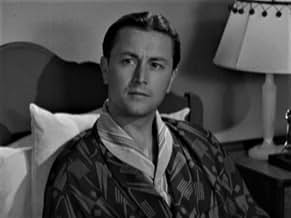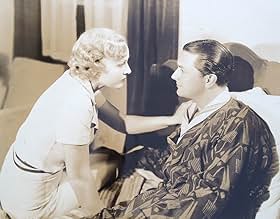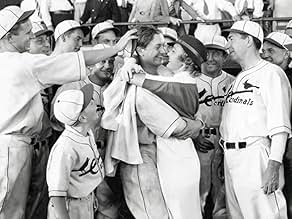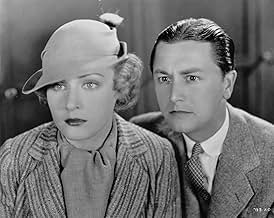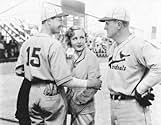Un equipo de béisbol perdedor comienza a perder a sus jugadores por extraños asesinatos, y el nuevo lanzador del equipo se esfuerza por encontrar al asesino.Un equipo de béisbol perdedor comienza a perder a sus jugadores por extraños asesinatos, y el nuevo lanzador del equipo se esfuerza por encontrar al asesino.Un equipo de béisbol perdedor comienza a perder a sus jugadores por extraños asesinatos, y el nuevo lanzador del equipo se esfuerza por encontrar al asesino.
- Dirección
- Guionistas
- Elenco
Joe Sawyer
- 'Dunk' Spencer
- (as Joe Sauers)
Ernie Alexander
- Dick
- (sin créditos)
Brooks Benedict
- Game Radio Announcer
- (sin créditos)
Bruce Bennett
- Man on Ticket Line
- (sin créditos)
Red Berger
- Baseball player
- (sin créditos)
Opiniones destacadas
Someone's trying to keep St. Louis's baseball team from winning the pennant by killing off the players!
No wonder this antique rarely if ever showed up on a Late Show. As a whodunit, the movie generates little suspense as a multitude of characters drift in and out of the meandering scenes. In fact, the plot with a shadowy character shooting players during the game is pretty contrived.
Then too, the occasional poorly done process shots, usually backgrounding Larry (Young), keep reminding you that this is after all only a movie. The badinage between umpire O'Toole (I think) and player Hogan about the former's eyesight gets tiresome even if it does turn poignant in the end. Then too, I don't know where director Sedgwick was during the confession scene, but as others point out, it has to be seen to be believed.
On the other hand, Young does a reasonable job emulating a big league pitcher and is his usual engaging self, while Evans (Frances) and Kelly (reporter Jimmie) outshine the third-rate material. As an old Cardinal fan from the days of Musial and Schoendienst, I did enjoy seeing shots of old Sportsman's Park packed to the rafters. Nonetheless, the movie just doesn't cut it, and not because of its creaky age.
No wonder this antique rarely if ever showed up on a Late Show. As a whodunit, the movie generates little suspense as a multitude of characters drift in and out of the meandering scenes. In fact, the plot with a shadowy character shooting players during the game is pretty contrived.
Then too, the occasional poorly done process shots, usually backgrounding Larry (Young), keep reminding you that this is after all only a movie. The badinage between umpire O'Toole (I think) and player Hogan about the former's eyesight gets tiresome even if it does turn poignant in the end. Then too, I don't know where director Sedgwick was during the confession scene, but as others point out, it has to be seen to be believed.
On the other hand, Young does a reasonable job emulating a big league pitcher and is his usual engaging self, while Evans (Frances) and Kelly (reporter Jimmie) outshine the third-rate material. As an old Cardinal fan from the days of Musial and Schoendienst, I did enjoy seeing shots of old Sportsman's Park packed to the rafters. Nonetheless, the movie just doesn't cut it, and not because of its creaky age.
There's an inherent danger in any movie director taking on a sports movie, and it's this: Very few directors know anything at all about the sport they're depicting, while the viewers they're courting know EVERYTHING about it.
That being a given, I am very impressed that this movie --- remember, it was made only a few years after talkies appeared --- has actual locations shots at L. A.'s Wrigley Field, Cincinnati's Crosley Field, and many actual MLB scenes at St. Louis's Sportsmans Park (Busch Stadium #1). That baseball shrine in north St. Louis was my Holy Grail as a boy.
Like a cop watching a crime movie and slapping his forehead going "That would never happen in real life", any true baseball fan will have his face-plant moments watching this --- like very early on when the put-upon umpire keeps pronouncing his title as "empire" --- but give it a chance. It's surprisingly authentic, and topical, with today's sports gambling clearly out of control, and MLB hanging its integrity from a Sword of Damocles human hair, making this 1934 movie a prescient parable of where pro sports' Faustian deal with gambling is certain to lead.
There's one gaffe so huge you could steer Elon Musk's ego through it: What should be the movie's most suspenseful scene, the denouement, instead is laugh-out-loud funny, in part due to a very poor choice of sound effect.
It was made not to be an Oscar nominee or Ebert's Great Movies entry, but just to be the final in a triplex at the corner movie theater, keeping summertime moviegoers buying popcorn and soda back when baseball was the national sport.
Set your expectations accordingly and you might enjoy it, especially when a baserunner is gunned down trying to score.
That being a given, I am very impressed that this movie --- remember, it was made only a few years after talkies appeared --- has actual locations shots at L. A.'s Wrigley Field, Cincinnati's Crosley Field, and many actual MLB scenes at St. Louis's Sportsmans Park (Busch Stadium #1). That baseball shrine in north St. Louis was my Holy Grail as a boy.
Like a cop watching a crime movie and slapping his forehead going "That would never happen in real life", any true baseball fan will have his face-plant moments watching this --- like very early on when the put-upon umpire keeps pronouncing his title as "empire" --- but give it a chance. It's surprisingly authentic, and topical, with today's sports gambling clearly out of control, and MLB hanging its integrity from a Sword of Damocles human hair, making this 1934 movie a prescient parable of where pro sports' Faustian deal with gambling is certain to lead.
There's one gaffe so huge you could steer Elon Musk's ego through it: What should be the movie's most suspenseful scene, the denouement, instead is laugh-out-loud funny, in part due to a very poor choice of sound effect.
It was made not to be an Oscar nominee or Ebert's Great Movies entry, but just to be the final in a triplex at the corner movie theater, keeping summertime moviegoers buying popcorn and soda back when baseball was the national sport.
Set your expectations accordingly and you might enjoy it, especially when a baserunner is gunned down trying to score.
Death on the Diamond (1934)
** (out of 4)
I love a good murder-mystery but I think there are probably lines that shouldn't be crossed. This film passes that line and just keeps going and going and going. The Manager/Owner of the St. Louis Cardinals pays good money to bring in star pitcher Larry Kelly (Robert Young) so that they can win a championship and save the team. Someone else doesn't want them to win and soon players are being killed one by one. It's up to Kelly and the owner's daughter (Madge Evans) to try and strike up a relationship as well as catch the madman. I think having a murder-mystery set on a baseball field is pretty far-fetched but I guess with the right screenplay something entertaining could have been done with it. Sadly, this isn't the screenplay and in the end one can't help be rather bored by the actual story but nevertheless the film manages to be entertaining simply because you haven't seen anything like it before (or since). I think the biggest problem is that the story, in its "B" picture form, just doesn't have enough to make it interesting. Can you imagine if baseball players were really getting picked out what type of stuff would be happening? Terror from the players, the opposite team, the fans coming to the game and I'm pretty sure the media would be all over a player being shot and killed while rounding third base. The story here pretty much looks at the players, the owner and a few cops so there's nothing big or believable that happens. The film offers up everyone as a red herring and I must admit that I laughed out loud when the killer was finally shown. How we learn who it is and what follows almost makes this movie an instant classic. Young and Evans both turn in decent performances and the two seem to be having a good time with all the flirting. Nat Pendleton and Ted Healy are on board and the supporting cast includes Joe Sawyer in a small role and we even have a very young Mickey Rooney playing the ball boy. Ward Bond and Walter Brennan also have small, uncredited roles. Fans of the genre will probably want to check this out if they're like me and just want to see every film of its kind. Others will probably hit the stop button well before the ending but the strangeness of this film and the weird story keeps its mildly entertaining.
** (out of 4)
I love a good murder-mystery but I think there are probably lines that shouldn't be crossed. This film passes that line and just keeps going and going and going. The Manager/Owner of the St. Louis Cardinals pays good money to bring in star pitcher Larry Kelly (Robert Young) so that they can win a championship and save the team. Someone else doesn't want them to win and soon players are being killed one by one. It's up to Kelly and the owner's daughter (Madge Evans) to try and strike up a relationship as well as catch the madman. I think having a murder-mystery set on a baseball field is pretty far-fetched but I guess with the right screenplay something entertaining could have been done with it. Sadly, this isn't the screenplay and in the end one can't help be rather bored by the actual story but nevertheless the film manages to be entertaining simply because you haven't seen anything like it before (or since). I think the biggest problem is that the story, in its "B" picture form, just doesn't have enough to make it interesting. Can you imagine if baseball players were really getting picked out what type of stuff would be happening? Terror from the players, the opposite team, the fans coming to the game and I'm pretty sure the media would be all over a player being shot and killed while rounding third base. The story here pretty much looks at the players, the owner and a few cops so there's nothing big or believable that happens. The film offers up everyone as a red herring and I must admit that I laughed out loud when the killer was finally shown. How we learn who it is and what follows almost makes this movie an instant classic. Young and Evans both turn in decent performances and the two seem to be having a good time with all the flirting. Nat Pendleton and Ted Healy are on board and the supporting cast includes Joe Sawyer in a small role and we even have a very young Mickey Rooney playing the ball boy. Ward Bond and Walter Brennan also have small, uncredited roles. Fans of the genre will probably want to check this out if they're like me and just want to see every film of its kind. Others will probably hit the stop button well before the ending but the strangeness of this film and the weird story keeps its mildly entertaining.
The only reason to see this picture is for its historical value. You can trace the beginnings of some Hollywood careers as the film contains some famous movie names. It is also an interesting commentary on how sophisticated Major League baseball has become in the ensuing years; major league rules, regulations and business structure - how innocent and unstructured life and baseball were years ago.
It's a nice vehicle for Robert Young and the lovely Madge Evans but the story is trite and predictable. There are numerous plot holes to navigate but if you can just overlook them you can make your way through a harmless 69 minutes.
It's a nice vehicle for Robert Young and the lovely Madge Evans but the story is trite and predictable. There are numerous plot holes to navigate but if you can just overlook them you can make your way through a harmless 69 minutes.
Seeing that this film was released in September of 1934 when in real life the St. Louis Cardinals were in a tight pennant race with the New York Giants, it's a wonder that this film didn't give some miscreant the idea of doing in the Dean brothers who were to lead the famous Gashouse Gang to the National League pennant and World Series that year.
The Cardinals are in desperate financial straights this year as owner/manager David Landau and daughter Madge Evans put the team in hock to get star pitcher Robert Young. Madge has a thing for Bob, but other players have a thing for Madge.
In the meantime the rejuvenated Cardinals are screwing up all kinds of gambling interests who don't want to see the long-shot Cardinals win the pennant. They'll stop at nothing including murder to see the Redbirds of St. Louis don't triumph. Murders of three players do occur before the culprit is found.
Nat Pendleton and Ted Healy provide the comic relief as a perpetually quarreling catcher and umpire. Someone did some research for this film or was a fan because legendary umpire Bill Klem who was still active in 1934 had an unbelievable aversion to the name of 'Catfish'. In Healy's case Pendleton calls him 'Crawfish' to get his goat.
Some establishing shots will give you a look at Sportsman's Park in St. Louis which is long gone now. Otherwise the cast MGM put together for this film shot it in and around Wrigley Field in Los Angeles, the minor league park of the Los Angeles Angels of the Pacific Coast League which also now history.
The ending of the film is the very least bizarre. Nearly the entire cast is suspect at one point, but the guilty party in this baseball mystery comes right out of left field. No, the left fielder didn't do it.
Paul Kelly has a very good role as a sportswriter with a nose for news that serves him well, the scoops he does get in this film.
I might have liked the film better had the ending which I can't reveal been so bizarre. It did give one player an opportunity for a grand piece of scenery chewing.
The Cardinals are in desperate financial straights this year as owner/manager David Landau and daughter Madge Evans put the team in hock to get star pitcher Robert Young. Madge has a thing for Bob, but other players have a thing for Madge.
In the meantime the rejuvenated Cardinals are screwing up all kinds of gambling interests who don't want to see the long-shot Cardinals win the pennant. They'll stop at nothing including murder to see the Redbirds of St. Louis don't triumph. Murders of three players do occur before the culprit is found.
Nat Pendleton and Ted Healy provide the comic relief as a perpetually quarreling catcher and umpire. Someone did some research for this film or was a fan because legendary umpire Bill Klem who was still active in 1934 had an unbelievable aversion to the name of 'Catfish'. In Healy's case Pendleton calls him 'Crawfish' to get his goat.
Some establishing shots will give you a look at Sportsman's Park in St. Louis which is long gone now. Otherwise the cast MGM put together for this film shot it in and around Wrigley Field in Los Angeles, the minor league park of the Los Angeles Angels of the Pacific Coast League which also now history.
The ending of the film is the very least bizarre. Nearly the entire cast is suspect at one point, but the guilty party in this baseball mystery comes right out of left field. No, the left fielder didn't do it.
Paul Kelly has a very good role as a sportswriter with a nose for news that serves him well, the scoops he does get in this film.
I might have liked the film better had the ending which I can't reveal been so bizarre. It did give one player an opportunity for a grand piece of scenery chewing.
¿Sabías que…?
- TriviaFred Graham was working in the MGM sound department and also playing baseball semi-professionally in his off-time. He was hired to tutor star Robert Young in baseball techniques. He also was hired to double Nat Pendleton in his scenes as a catcher, thereby beginning a nearly 40-year career as an actor and stuntman.
- ErroresWhen the game resumes, after the bad guy is caught, the camera pans across the scoreboard to show that the game is tied, 2-2. The radio announcer then states, "Cincinnati hasn't scored since Kelly threw that ball into the dugout and let the tying run come in." Cincinnati was the visiting team and the last run it scored, in the top of the second inning, would have made the score 2-1 (Cincinnati leading). It would not have been a tying run.
- Bandas sonorasTake Me Out to the Ball Game
(1908) (uncredited)
Music by Albert von Tilzer
Lyrics by Jack Norworth
Played during the opening and closing credits
Played as background music often
Selecciones populares
Inicia sesión para calificar y agrega a la lista de videos para obtener recomendaciones personalizadas
Detalles
- Fecha de lanzamiento
- País de origen
- Idioma
- También se conoce como
- King of the Diamond
- Locaciones de filmación
- San Luis, Misuri, Estados Unidos(baseball diamond and grandstand backgrounds)
- Productora
- Ver más créditos de la compañía en IMDbPro
- Tiempo de ejecución1 hora 11 minutos
- Color
- Relación de aspecto
- 1.37 : 1
Contribuir a esta página
Sugiere una edición o agrega el contenido que falta

Principales brechas de datos
By what name was Death on the Diamond (1934) officially released in India in English?
Responda
